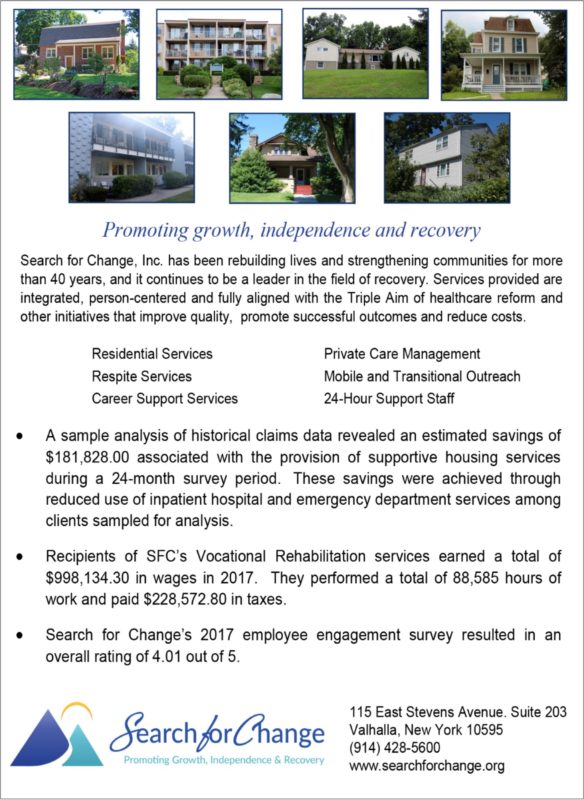An abundance of evidence now confirms what most behavioral health professionals have suspected for many years – safe and stable housing, coupled with appropriate health and social support services, reduces recipients’ reliance on costly emergency and institutional care services (Martinez & Burt, 2006). The development of an adequate stock of supportive housing for vulnerable individuals is therefore essential to the fulfillment of various transformative initiatives presently underway. Enactment of the NYS Value Based Payment (VBP) Roadmap, maintenance of gains achieved under the Delivery System Reform Incentive Payment Program (DSRIP) (notwithstanding the federal government’s denial of a request to renew this initiative), and the continuing deinstitutionalization of individuals formerly housed in state-operated psychiatric facilities, nursing homes, and adult care facilities (i.e., adult homes) require a supportive housing infrastructure of sufficient size and specialization to accommodate a rapidly rising demand. Key stakeholders to our supportive housing system anticipated this need at the outset of the foregoing initiatives and advocated for sweeping changes accordingly. Some changes have followed, but much work remains to be done if our housing services are to fulfill their emerging mandates.

Ashley Brody, MPA, CPRP
There have been at least some auspicious developments to this end. For instance, the Empire State Supportive Housing Initiative (ESSHI) was enacted in 2016 and provides for the development of “integrated” housing for individuals with special needs in accordance with the NYS Olmstead Implementation Plan. This Plan constitutes the state’s response to a decision of the U.S. Supreme Court (Olmstead v. L.C.) that affirmed the right of individuals with disabilities to reside in the “least restrictive settings” practicable. Housing developments funded under the ESSHI allocate “supportive” and “affordable” housing units in equal measure. That is, a “typical” ESSHI development allocates approximately 50% of its units for individuals with behavioral health conditions or other special needs and the balance for individuals who qualify in accordance with economic criteria (but do not necessarily experience chronic health conditions or other special needs). Thus, ESSHI developments integrate special needs populations with the “general” population. They do not segregate persons with disabilities as other housing models do. This approach, regarded by many as considerably more progressive than its antecedents insofar as it includes independent, mixed-use, and fully integrated residential accommodations for individuals with special needs, has surely advanced some of the goals described above. Nevertheless, unlike other models that rely on existing housing stock, ESSHI developments customarily entail the construction of new housing units or rehabilitation of structures that are no longer serviceable. These are daunting and time-consuming tasks, to be certain. Housing developers must navigate a byzantine labyrinth of fiscal and regulatory challenges that include restrictive and often exclusionary zoning ordinances; community opposition (i.e., “nimbyism”); and identification of parcels suitable for individuals with special needs and of limited means (i.e., accessible to public transportation, retail establishments, and other essential community resources), among many others. The ESSHI is currently in the fourth of five “rounds” through which it aspires to develop a total of 6,000 new units of supportive housing throughout NYS. Not surprisingly, it has fallen far short of this goal. Regulators, policymakers, and other key stakeholders would do well to reexamine many of the foregoing impediments to housing development if the ESSHI and related initiatives are to fulfill their objectives and provide an adequate supply of integrated housing for eligible individuals.
Initiatives that promote the construction of new housing units for individuals with special needs are surely essential to the attainment of the state’s policy goals and the amelioration of our affordable housing crisis. Nevertheless, they are insufficient to satisfy the housing needs of a rapidly growing population marked by increasingly complex and acute service and support needs. The existing continuum of Office of Mental Health (OMH)-licensed and funded supportive housing programs must operate in synergy with emerging models in order to accommodate such complexity. Regrettably, however, the fiscal and regulatory underpinnings of the existing continuum have failed to evolve in concert with the changing landscape. Several of the supportive housing models presently in operation were established decades ago in order to provide stable living arrangements for individuals exiting institutional care settings, many of whom required little more than a modicum of support services in order to achieve enduring stability and community tenure. These housing models now accommodate individuals with increasingly acute and complex needs for which commensurate resources are required. That is, Community Residences, Service Enriched Single Room Occupancy (SRO) programs, and other supportive housing models must now support individuals with mental health conditions, comorbid substance use disorders, and frequently debilitating primary (physical) health conditions that elevate their risk of adverse outcomes. Naturally, many of these individuals require more intensive support services than are readily available within these settings, and this disparity between needs and resources has increased markedly in recent years. According to an analysis by the Association for Community Living (ACL), a membership and trade association that represents supportive housing providers throughout New York State, funding for these programs has eroded significantly during the past three decades (up to 70% for some) when measured against inflation (Association for Community Living, 2020). Moreover, Cost of Living Adjustments (COLAs) for the human services workforce has been deferred by the State Legislature nearly every year since it was codified in statute. This has compounded the economic crisis that afflicts supportive housing providers, making it exceptionally difficult for them to recruit and to retain personnel with the requisite qualifications to serve their current clientele. In short, an unfortunate confluence of ever-increasing needs and dwindling resources has strained portions of the existing continuum to their virtual breaking point. This jeopardizes society’s most vulnerable individuals – the ones for whom the supportive housing infrastructure was developed – and hampers our collective effort to achieve the laudable aims of healthcare transformation.
The adage “Housing is Healthcare” is often invoked among proponents of Social Determinants of Health who recognize their primacy in the healthcare equation. Nevertheless, housing, essential as it is, cannot deliver on its promise absent an adequate supply coupled with support services of sufficient scope and flexibility for those who require it most.
The author may be reached at (914) 428-5600 (x9228) or by email at: abrody@searchforchange.org.





